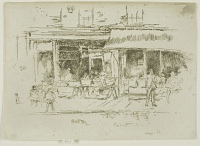Nut Shop, St James's Place, Houndsditch | ||
| Number: | 356 | |
| Date: | 1887 | |
| Medium: | etching and drypoint | |
| Size: | 128 x 178 mm | |
| Signed: | butterfly at left and (faint) at lower right | |
| Inscribed: | no | |
| Set/Publication: | no | |
| No. of States: | 2 | |
| Known impressions: | 5 | |
| Catalogues: | K.291; M.285 | |
| Impressions taken from this plate (5) | ||
KEYWORD
cat, children, city, people, shop-front, streetscape.
TITLE
There are various possible titles, as follows:
'Hounsditch Series' (1887/1888, Whistler). 2
'St James Place. [crossed out] Nut Shop' (1887/1888, Whistler). 3
'Nut Shop (Houndsditch)' (1888, Whistler) 4
'Nut Shop' (1889, Whistler). 5
'Nut Shop, St. James’s Place, Houndsditch' (1898, Wunderlich's). 6
'Nut Shop, Houndsditch' (1900, Caxton Club). 7
'Nut-Shop, St. James's Place' (1902, Edward Guthrie Kennedy (1849-1932)). 8
The Nut Shop. St. James's Place' (1903/1935, possibly Rosalind Birnie Philip (1873-1958)). 9
'Nut Shop, St James’s Place, Houndsditch' combines elements of Whistler's and later titles, and is the correct spelling. The alternative spelling, 'Hounsditch', is acceptable but less common.
'Hounsditch Series' (1887/1888, Whistler). 2
'St James Place. [crossed out] Nut Shop' (1887/1888, Whistler). 3
'Nut Shop (Houndsditch)' (1888, Whistler) 4
'Nut Shop' (1889, Whistler). 5
'Nut Shop, St. James’s Place, Houndsditch' (1898, Wunderlich's). 6
'Nut Shop, Houndsditch' (1900, Caxton Club). 7
'Nut-Shop, St. James's Place' (1902, Edward Guthrie Kennedy (1849-1932)). 8
The Nut Shop. St. James's Place' (1903/1935, possibly Rosalind Birnie Philip (1873-1958)). 9
'Nut Shop, St James’s Place, Houndsditch' combines elements of Whistler's and later titles, and is the correct spelling. The alternative spelling, 'Hounsditch', is acceptable but less common.
3: List, [1887/1888], GUW #13233.
4: Whistler to Wunderlich's, 29 June 1888, GUW #13052.
5: List, 18 July 1889, GUW #13235.
6: New York 1898 (cat. no. 191).
7: Chicago 1900 (cat. no. E307).
8: Kennedy 1902 (cat. no. 301).
9: Envelope containing copper plate, Hunterian Art Gallery.
DESCRIPTION
A view across a street to shops and part of the first floor of a building, drawn parallel to the edge of the copper plate. To left is a shop with an open doorway, with baskets on boards laid on two sets of trestles in front. Three children peep out above the baskets. Three children and a cat stand on the pavement at left, and another cat on the road in the foreground. At the right is another shop with wares on tables displayed under an awning. A man is standing on the pavement in front of this shop, and near him, at far right, are a man and woman, roughly outlined.
SITE
St James's Place, Houndsditch, London E.C. is off Aldgate and Duke Street. 'Houndsditch' and 'Hounsditch' are both accepted spellings. St James's Place was at the heart of the Jewish section, and was the site of the great Synagogue, as well as the Fishmonger's Arms, and a number of fruit and vegetable shops.
In 1851 Mayhew described 'THE ORANGE AND NUT MARKET' as follows:
In Houndsditch there is a market supported principally by coster-mongers, who there purchase their oranges, lemons, and nuts. This
market is entirely in the hands of the Jews; and although a few
tradesmen may attend it to buy grapes, still it derives its chief
custom from the street-dealers who say they can make far better
bargains with the Israelites, (as they never refuse an offer), than
they can with the Covent-garden salesmen, who generally cling to
their prices. This market is known by the name of 'Duke's-place,'
although its proper title is St. James's-place.'Duke's-place — as the costers call it — is a large square yard,
with the iron gates of a synagogue in one corner, a dead wall forming one entire side of the court, and a gas-lamp on a circular pave-ment in the centre. The place looks as if it were devoted to money
making — for it is quiet and dirty. Not a gilt letter is to be seen over
a doorway; there is no display of gaudy colour, or sheets of plate-glass, such as we see in a crowded thoroughfare when a customer
is to be caught by show. As if the merchants knew their trade was
certain, they are content to let the London smoke do their painter's
work. On looking at the shops in this quarter, the idea forces itself
upon one that they are in the last stage of dilapidation. Never did
property in Chancery look more ruinous. Each dwelling seems as
though a fire had raged in it, for not a shop in the market has a
window to it; and, beyond the few sacks of nuts exposed for sale,
they are empty, the walls within being blackened with dirt, and
paint without blistered in the sun, while the door-posts are worn
round with the shoulders of the customers, and black as if charred.
' 10
10: Henry Mayhew, London labour and the London poor, London, 1851, at http://archive.org (accessed 2012).
By the time that Whistler etched the scene, over 30 years later, it was a relatively poor but respectable working-class neighbourhood. Whistler etched another view of St James's Place, St James's Place, Houndsditch [255]. There were several other St James's Places, St James's Roads, St James's Squares and St James's Streets in London, but only one in Houndsditch.

